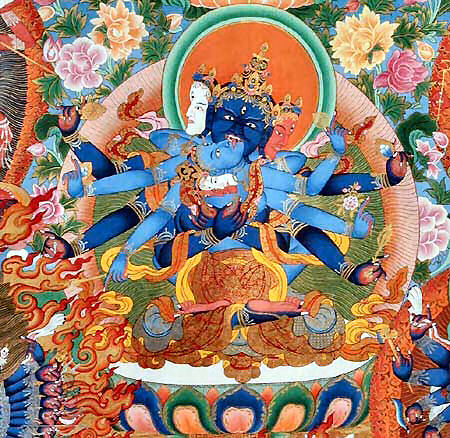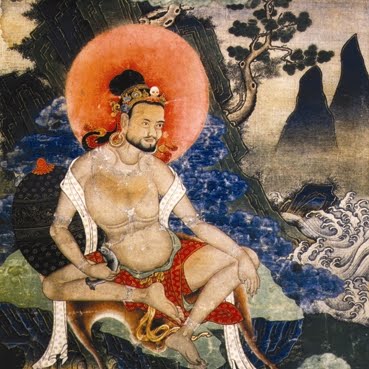
FIRESTAR
SEASON NOTES
As Utilized by the 5 Mt System of Miryai
This season begins sometime between March 20 and
April 4, and lasts about 73 days. Sucess during this five fortnite season
can be measured in an increased ability to focus and direct energy into
constructive areas. Long term, multi year measurements of sucess
should be seen as a gradual tempering of anger, development of less caustic
communication skills, more adept skill in ones chosen trade, proffession
or talent arena. The symbol of this constructivily directed energy are
the tools of ones trade, workshops and offices.
Introduction into Bon
SEASONAL OVERVIEW
-
ABSTRACT: A value of the Fire Path lies in its insight
into non duality. Achieving a Dzogchenian Unified View as taught by Yeshey
Tsogyal. Reconnecting to one's True Self and interacting with others on
that deeper level.
-
GOAL: Abiding in Dzogchen. Living in non duality.
-
PROBLEM: Dualistic viewpoints engender suffering.
-
REASON: Dichotomy of the materialsitc world creates
differentiation in worldview.
-
HISTORY: Existant since the beginning....
-
REMEDY: Employing rational, reasoning and exercises
held dear in Dzogchen.
-
METHODOLOGY: A five fortnight practice period designed
to go, step by step, thru the various levels that lead toward Dzogchen.
-
RYTHYMN: The 72 day practice schedule - 5 & 15
day periods:
-
APPROACH: Let the practices and teachings be
adapted to a coed Monastery/Farm Collective/Family/Isolated individual:
4 pronged program applicable to each type of situation and enviroment.
-
EXAMPLES: Yeshey Tsogyal. Shinrab Miwo, Padmasambhava
and others.
-
RECORDS: Bonpo
Book of the Dead (+Oral Tradition from Zhang Zhung & misc Dzogchen
& Bon); Life and Visions of Yeshe Tsogyal (+Advice
from Lotus Born, Juniper
Ridge & misc Vajrayana,
some Sikh, Jain & Shaivite); Collection
of Studies on Bon
-
WEEDING: The recognition and avoidance of pitfalls
found in history and texts: Movement away from guru adoration, insane repitition
of Ngondro exercies, etc.
-
PROCEDURE: During each fortnight let the practicioner
utilize the 5 Treasures of Shinrab:
-
CONCLUSION: Upon the conclusion of the fortnight
an evaluation of progress should be made made
-
INSIGHTS: Notes for future attempts in the following
year are advantageous
-
PARADOX: The enigmas of this facet and formula of
transcendance
-
WARNINGS: Avoid self delusion and ego aggrandizement
arising from any spiritual experiences or profound understandings during
the fornight.
-
ENDING: The closure of the period, giving away
merit, owning change, fortnight fast, reset/reboot
Preface
The five divisions—Bon, Shakta/Jain/Sikh, Nyingma,
New Translation Schools (Kagyu, Sakya, Gelug), and Dzogchen—span Tibetan
and Indian spiritual traditions, each with three historical movements rooted
in verifiable histories and practices. These movements, evolving from ancient
origins to later syncretic forms, emphasize unity between inner and outer
realms through rituals like fire rites, meditations like Dzogchen, and
devotional acts like langar, reflecting a shared pursuit of transformation
and awareness. Despite distinct trajectories, they converge on ecological
and spiritual connectivity, though challenges like historical ambiguity,
accessibility, and doctrinal rigidity persist across their expressions.
-
Zhang Zhung (Shenrab Miwo); Old Bon, New Bon, Naxi,
Dragon Text.
-
Indus, Harrapan, Yangtze Cultures, Green Man, Shiva,
Shakti, Shaivites, Shaktism; Jains, (Mahavira, Buddha, Sidharta); Sikhs,
(Nanak).
-
Padmasambhava/Nyingma 8th c CE; Yeshe Tzogyal/Mother
Lineage; Ngakpas.
-
Kagyu 11th c (Meditation/True Nature); Sakya 1073
CE (Develop/Creation Stages); Gelug 1409 CE (Study/discipline).
-
Dzogchen (Semde); Dzogchen (Longde); Dzogchen (Menngagde).
These fifteen expressions share strengths in unifying
inner and outer worlds through transformative practices—fire rites, meditations,
service—rooted in ecological and spiritual awareness, offering paths to
enlightenment via disciplined realization. Bon’s prescientific ecology
lacks modern validation; Shakta’s union faces celibacy tensions; Jainism’s
asceticism limits appeal; Sikhism’s simplicity risks oversimplification;
Nyingma’s esotericism challenges newcomers; Kagyu’s oral focus resists
codification; Sakya’s complexity narrows reach; Gelug’s rigor may stifle
intuition; Dzogchen’s depth demands readiness. Yet, their diverse approaches
collectively enrich human spiritual potential.
Contrasts of various
Paths and Seasonal Focus
 The
Spring Session is designed to extrapolate useful concepts and practices
from the Himalalan culture, especially the Bonpo tradition. Its most useful
tools lie in its emphasis on mental training and in its concept of "Dzogchen".
The
Spring Session is designed to extrapolate useful concepts and practices
from the Himalalan culture, especially the Bonpo tradition. Its most useful
tools lie in its emphasis on mental training and in its concept of "Dzogchen".
Peace to all....
Return to Home Page
Yesai the Nazorean 2015 - All Rights
Reserved



 The
Spring Session is designed to extrapolate useful concepts and practices
from the Himalalan culture, especially the Bonpo tradition. Its most useful
tools lie in its emphasis on mental training and in its concept of "Dzogchen".
The
Spring Session is designed to extrapolate useful concepts and practices
from the Himalalan culture, especially the Bonpo tradition. Its most useful
tools lie in its emphasis on mental training and in its concept of "Dzogchen".

![]()